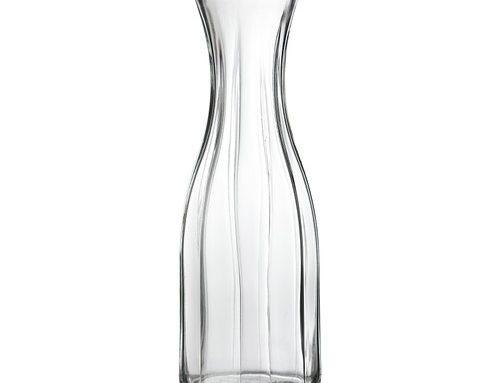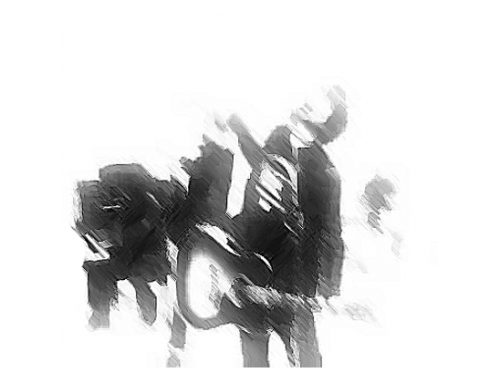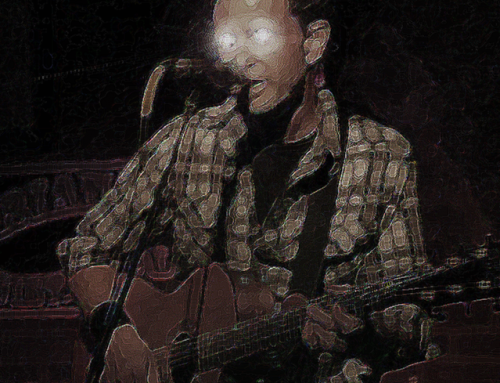I stood next to the GraniTight™-topped island in my kitchen, procrastinating over a cup of coffee by considering the spurious nature of an improvement that you could spray on to any surface. The original formica-covered pressboard was covered by mere millimeters of the coating, and while it appeared genuine enough, a few taps of my fingernails revealed its duplicitous nature with the hollow clicking that one wouldn’t necessarily correlate with anything igneous, a detail that had been overlooked by the manufacturer’s specifications. The quartz, feldspathic and mica appearance served it’s purpose well enough. The notion of breakfast wrinkled my forehead momentarily.
Instead, I walked down the hallway towards the bedroom. The wall across from the coat closet door was peppered with picture frames that were not quite level and had a fine layer of dust draping the top edges. Kelly and I sprawled into an enormous hammock on our honeymoon, profoundly hungover and marginally mindful of the St. Martin beach in the background, sweaty from the humidity which was so contrasting form the high desert we were used to. Kelly holding Kaylyn close next to a fire during an unseasonably cold Memorial Day trip when Kaylyn was three to the unmarked six-space campground we had found by English Lake that had a rather sizeable outhouse that always seemed to be clean although we had never once even seen a Park Ranger drive by. Kelly with an overenthusiastic thumbs up next to her first new car in years, the light blue Honda Accord that, as far as I knew or had the resolve to resolve, she was still driving. A row of four school mandated headshots, lighting and digital resolution vary in an inverse proportion to how tangled Kaylyn’s hair was that particular day–with the exception of the last in which she wore a brightly colored catmini spirit ethnique headscarf and a sideways smile from me whispering in the background that it sure was a nice hippie dippy rag on her head.
As I reached the open door to the haughtily-named master suite that was more equitably a bedroom with an attached bath, I could hear the muffled but indignant buzz of my phone vibrating somewhere mixed into the turbulent tangle of sheets and the floral print duvet that was on the lengthening but nearly abandoned replacement agenda. With one hand still appreciatively wrapped around the diminishing warmth of my coffee mug, I fumbled artlessly with my left until I grabbed it, barely beating automated voice messaging.
“Yellow.”
“Holy fuck, I wish you would stop answering the phone like that.” It was my sister, Candace.
“As you’ve said. So, so many times.”
“Yeah, whatever.” She continued with a what I summarily hoped would be a summary of the two weeks since she had last called. Inexorably for a period of six months, after Kaylyn had conceded defeat to the inexorable progress of the hemangiosarcoma, Candace’s calls had adhered to a circadian, consistent sequence. Early evening every day, the postprandial. She was deliberately scrupulous not to let the conversations lapse into silence, and at the time I didn’t appreciate the level of altruistic selflessness as she apportioned out bits and pieces of her life to me that under different circumstances may have otherwise been confidential. I gathered up technicalities and minutiae of her job as an software engineer as if it were a bulwark. I absorbed the litany of flaws and failures, many of them her own, that made up the chronicle of her as yet unsuccessful relationships and forged her steely resolve. Over time, however, the urgency with which I had listened had faded.
Paradoxically, I hoped her outpouring was a kindness that would never require reciprocity.
The eldest by twenty-two months, she was my advocate when, as children, she would champion whatever cause we had taken upon ourselves to accomplish. Mud pies messes and cookie thefts. As we matured into adolescence, our relationship evolved. Coincidental to my surpassing her in height, I would soon usurp her mantle as the protector. Any boys caught glad-handing or otherwise offering inappropriate advances would have felt my wrath. I supposed that this recent transformation was not out of line with history.
“You’re not inviting Kelly to join us at Crestwicke today, right?” Candace’s voice always dropped about half an octave when she mentioned Kaylyn’s mother. She was acutely and vigilantly more belligerent about Kelly abdicating her responsibilities halfway through the second round of chemo than I was. She was likewise naive. Kelly’s father had been diagnosed with amyotrophic lateral sclerosis–Lou Gehrig’s Disease–when she was burgeoning into her teen years, and at a time when other girls were occupied with boys and music and clothes and the mall, Kelly had been tethered to home much of the time, whenever her mother was at work or making one of her frequent pharmaceutical runs, or simply needed an alternate for the sake of support. It had been a source of contention early in our relationship. She found it difficult to invest herself in another when, in her experience, the possibility of another such misfortune evinced such a visceral fear. To me it wasn’t surprising that she couldn’t stand the thought of watching someone she cared for in the progressive, aggressive diminishing to such an abhorrent demise again.
I told her no, and explained that such a thought had never crossed my mind. She sighed a relief and made sure to verify the details for our reservation and then we said our goodbyes and I hung up the phone.
I threw the phone back onto the bed, fully aware that it was going to get disappear into the bedclothes again. I decided against a shower for a second consecutive day, but I did pass over the aggregation of worn, unlaundered clothes that was layering like a stromatolite in the corner by the closet.
My office at the University was just across Millards River from the subdivision I lived in, and as I had not stopped by in almost a week I thought it would be in my best interest to make the short journey and go through my mail and other pertinent matters that were going to require my attention.
The paleobiology department was tucked into a corner of the top floor of the Natural History Annex, itself an adjunct of Lewiston Hall. The Annex had been one of the more curiously remarkable additions to the campus when it was built in 1962, with it’s blend of traditional and modern styles from architect J.M White. Formed of brown brick and trapezoidal in shape, the exterior was quite unlike any of the other buildings on the Quad. The interior, conversely, was straight college-class 101. My feet traced a path worn into the tile from the entrance to the stairs from the mass of students and faculty that had walked it in the intervening half a century. The stairs themselves, at least up to the second floor, were marble; and these, too had tracks worn on both sides. On the second floor, I turned right and, without paying much attention I followed the corridor to the T junction and made a left, and opened the second door on the right with the stairs leading up to the back side of Paleo, knowing that if I walked in through the front entrance Benjamin the Administrative Assistant would want to pass off a handful of messages from the dean, I already knew what they were going to say, there were many just like them already haphazardly strewn over the top of my desk.
While I hadn’t taken advantage of bereavement leave, but the first semester after Kaylyn’s diagnosis I had dropped the number of classes I taught down to one, the bare minimum I could teach and keep my status as an Associate Professor active. Jim Hartwell, the Dean of the Archaeology department and thus the de facto head of the Paleobiology department had been relentless in his pursuit of getting me to get back to teaching the three of four classes per semester that was truly expected of my status.
I sat down at my desk and started rifling through the mix of paperwork and student assignments. I did always make sure that the assignments were up to date and returned graded on time. After I had been sitting at my desk and grading a few papers, I heard a light rap on the edge of my doorframe and I looked up.
“Hello sir.” Philip Graham. He was one of the tenured professors in the department, mid 50s and getting a little wider in the middle than he used to be when I met him during my first week on faculty, five years ago.
Philip
I could only procrastinate for so long, and it was time to leave the office. I left through the front this time, but not before tilting my head around the corner and seeing if Hartwell was lurking near the front door. It looked to be safe, and I stepped out. My hand was almost touching the know when a head pops up from underneath the Benjamin’s desk.
“blah.”
Outside of the office was the aging Burgess Shale display. When Kaylyn would visit, she would sometimes she would stop to admire it, and pick out one of the creatures. Along with a map of the location in Canada and a single color artist’s rendering of the odd and anomalous fauna of the time, there was a map of the original site in the Canadian Rockies in British Columbia and a series of prints of the original black and white photos taken by Charles Wolcott in 1910, a year after he first stumbled upon the site when he returned with his wife, two sons and daughter to further explore the discovery.
While the
When I finally walked out the door, my phone rang again, it’s Candace.
The drive to Crestwicke runs through the center of town.
Kaylyn’s grave is near the south side. I sat there until I heard someone walking up behind me, it was Candace.
“I know what you said, but I thought maybe you would appreciate it if I showed up.”
“The last time Kaylyn was at my office, the day after we received the results from her biopsy and a week before she started the chemo, I remember her standing at the Burgess display outside my office. Do you remember it?” Candace nods. “She was always so fascinated by anomalocaris, one of the earliest predators that we have any evidence of. She said it looked like it had shrimp hanging out of its mouth.”
“I know exactly which one she was talking about.”
“I had always wanted to tell her the story of hallucigenia. This was a creature that doesn’t fit into any of the taxonomical categories we have, or at least we thought it didn’t. When Wolcott first described it, he wasn’t sure which way was up or down, front or back. She was always so curious. I thought she would find the story fascinating.”
I stopped for a while, sitting silently. Candace comes up closer behind me and sat down, putting her hand on my shoulder.
“Over the years, there were many different theories over what it was. Whether or not the spikes were the feet or spines on its back, if the bulbous end or the snout-looking protuberance was the head.”




Leave A Comment